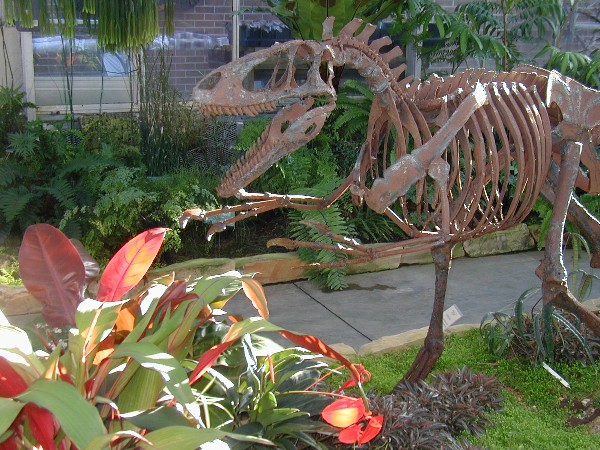The city of Marion is soliciting ideas from local residents and other interested parties for improving city life and strengthening its identity in a program they are calling Imagine8. I’ve been working with a group of friends and supporters of the Eastern Iowa Paleontology Project (EIPP) to develop a statement encouraging an initiative to improve natural science education in the city. We all agree it would be very nice if we can create a permanent home for our dinosaur in the process, but more important is encouraging science education. You would think with the shortage of engineers, scientists, doctors and other health professionals in this country and our pressing environmental needs that there would be more support for teachers and families wanting to encourage their children in this direction but science funding always trails far behind that for culture and the arts. Since Cedar Rapids hasn’t called me yet about redeveloping their flooded downtown area into an Ice Age Sloth Park , I’m planning to dust off the idea for Marion and propose it as part of a general botanical center.
Proposed: To promote natural science education and build a strong community identity Marion should establish a botanical center managed like the Chicago Botanic Garden and the Minnesota Landscape Arboretum in Minnneapolis (among many others). A huge volunteer army has formed to help maintain these gardens and they have become the center of social activity in their communities. E. Iowa garden clubs are as varied as the plant world, with different ones devoted to roses, hostas, water plants, fruit, vegetables, herbs, heirloom plants, prairies, succulents, conifers, terrariums and bonsai, in addition to several with a general interest. Every one would volunteer to design, plant and maintain a garden focused on their passion, and where no club currently exists one would quickly coalesce from local experts given the opportunity.
A botanical center would be a distinctive jewel for Marion and a magnet for senior citizens, school teachers, tourists and families interested in nature, birding, wildlife, ecology, etc. A botanic garden would send a powerful signal to business about the community’s commitment to children and science education. The center would become an important nexus between area colleges and universities, with Kirkwood (the local community college) offering considerable practical horticultural experience and students; Iowa State University (in nearby Ames) adding a high-tech/ag/research dimension; and the University of Iowa bringing an impressive collection of paleobotanical fossils and expertise to the table, in addition to a world-famous environmental engineering program.
Partnerships might also be explored with the many area companies involved in the agriculture, bioremediation and biofuel industries. With a small staff committed to coordinating self-governing volunteer organizations, and the research operations funded by industry and the universities, operating costs would stay low versus the benefits reaped. Gardeners are patient, with nurturing as the objective, not immediate gratification, so unlike any other project the city will consider, a botanical center would pay dividends from its inception, expand as the budget and Marion’s vision permits, and improve with age.
Sloth Woodland and a Dinosaur Fern Garden would be terrific family attractions in a botanical center. If you want to submit some ideas of your own supporting paleontology, natural science, or children’s science education here’s a link to the Marion Imagine8 home page. . . . Dave.</that’s>


Dave, It’s a cool idea and it makes a lot more sense than turning the whole Cedar Rapids downtown into a park. What would you do with all the people anyway? Where are they supposed to live and how are they supposed to make a living?
Trav, It has been done before; we have the perfect model in Indianapolis, IN. Their downtown riverfront was a blighted mess of neglected houses, deteriorating businesses and abandoned properties in the 1970’s. The state created a commission to start acquiring the land and turned it into a one-of-a-kind downtown park, the White River State Park. They opened the Indianapolis Zoo there in 1988 and an art and culture museum in 1989. In 1996 they built a minor league baseball field and IMAX in the park; in 2000 a sports museum. In 2002 a state history museum opened. Now 3 million visitors/year are attracted to the institutions and the events they sponsor in the park’s many open areas– e.g. amphitheatre, hiking and bike paths, sculpture garden, etc. Thousands of new jobs have been created.
The flooded Cedar Rapids neighborhoods were never blighted like this of course, but they are certainly candidates for massive urban renewal now. The last thing in the world I want to do is abandon the flood victims, but I hate to see us remain in our current state of denial that the neighborhoods and jobs will return and the floods won’t. The experts say global climate change has upped the odds significantly and that floods are going to be a common occurrence in the future (i.e. 1:17). Geologists put no faith in the billion $$ control system the consultants are recommending–they never work in the long term. Nor will federal $$ ever flow as freely as we hope. The big downtown businesses (e.g. Alliant Energy) are already placing their bets and moving out. I’m afraid the city is on course for a permanent economic decline. Help the victims relocate and give them a reason to hope for a brighter and smarter future (with a sloth garden). . . . Dave
Reference http://www.brookspublications.com/files/WRSP_may08.pdf